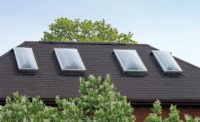Win-Win Scenarios
“Green” and “sustainable” are current buzzwords in construction, but a look at the pages of this issue of Architectural Roofing & Waterproofing shows that these concepts are being implemented in the world of roofing, despite a tough economy.
“Green” and “sustainable” are current buzzwords in construction, but a look at the pages of this issue of Architectural Roofing & Waterproofing shows that these concepts are being implemented in the world of roofing, despite a tough economy. From the vegetated roof on the Target Center in Minnesota to the building-integrated photovoltaic system at Providence College in Rhode Island to the residential solar kit manufactured in Michigan, technologies designed to lessen impact on the environment, improve energy efficiency, and even generate power are now becoming commonplace.
Garden roofs that improve aesthetics, reduce storm water runoff, and reduce utility costs have obvious benefits. So do solar systems that generate electricity to power buildings. But there are other, less glamorous ways to help the environment. Extending the life of existing roofs by conducting regular maintenance is one way to help building owners get the most out of their investment. Designing roof systems that are stronger and more durable is another. Installing replacement roofs without tearing off existing materials can prevent truckloads of waste from going to the landfill.
Systems that have lower life-cycle costs, reduce energy use, create less waste, and minimize the urban heat island effect are good news for building owners, architects, contractors and the environment. That’s a true win-win scenario.
“Green” and “sustainable” are current buzzwords in construction, but a look at the pages of this issue of Architectural Roofing & Waterproofing shows that these concepts are being implemented in the world of roofing, despite a tough economy. From the vegetated roof on the Target Center in Minnesota to the building-integrated photovoltaic system at Providence College in Rhode Island to the residential solar kit manufactured in Michigan, technologies designed to lessen impact on the environment, improve energy efficiency, and even generate power are now becoming commonplace.
Garden roofs that improve aesthetics, reduce storm water runoff, and reduce utility costs have obvious benefits. So do solar systems that generate electricity to power buildings. But there are other, less glamorous ways to help the environment. Extending the life of existing roofs by conducting regular maintenance is one way to help building owners get the most out of their investment. Designing roof systems that are stronger and more durable is another. Installing replacement roofs without tearing off existing materials can prevent truckloads of waste from going to the landfill.
Systems that have lower life-cycle costs, reduce energy use, create less waste, and minimize the urban heat island effect are good news for building owners, architects, contractors and the environment. That’s a true win-win scenario.
Looking for a reprint of this article?
From high-res PDFs to custom plaques, order your copy today!





.png?height=200&t=1734717480&width=200)